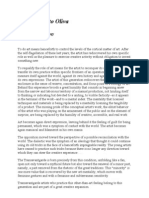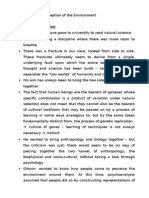Angel Tooo
Angel Tooo
Uploaded by
EjaselleCopyright:
Available Formats
Angel Tooo
Angel Tooo
Uploaded by
EjaselleOriginal Description:
Copyright
Available Formats
Share this document
Did you find this document useful?
Is this content inappropriate?
Copyright:
Available Formats
Angel Tooo
Angel Tooo
Uploaded by
EjaselleCopyright:
Available Formats
The House of the Sleeping Beauties House of the Sleeping Beauties
Author(s) Original title Country Language Genre(s) Publication date
Yasunari Kawabata
Nemureru Bijo' Japan Japanese Novella 1961
House of the Sleeping Beauties is a 1961 novella by the Japanese author Yasunari Kawabata.[1] A story about a lonely man, Old Eguchi, who continuously visits the House of the Sleeping Beauties in hope of something more. Plot The titular house is an establishment where old men pay to sleep besides young girls that had been narcotized and happen to be naked, the sleeping beauties. The old men are expected to take sleeping pills and share the bed for a whole night with a girl without attempting anything of "bad taste" like "putting a finger inside their mouths". Eguchi is presented with a different girl each time he visits the house because of the short notice of his visits. He discovers that all girls are virgins which somehow compels him to comply with the house rules. Each girl is different and the descriptions of his actions are mixed with the dreams that he has sleeping besides the girls.
The Master of Go
1981 Perigee Books edition The Master of Go is a novel by the Japanese author Yasunari Kawabata, first published in serial form in 1951. Titled Meijin () in its original Japanese, Kawabata considered it his finest work, although it is in contrast with his other works. Plot It is a semi-fictional chronicle of the lengthy 1938 "retirement game" of Go by the respected master Honinbo Shsai, against the up-and-coming player Minoru Kitani (although the latter's name is changed to Otak in the book). It was the last game of the master Shsai's career, a lengthy struggle which took almost six months to complete; he narrowly lost to his younger challenger, to die a little over a year thereafter. Themes Kawabata had actually reported on the match for the Mainichi newspaper chain, and some sections of the book are reworked versions of his original newspaper columns. The Japanese word used to describe the book is shsetsu, which may be translated as "chronicle-novel", but it is mostly true to life. The book has many layers of meaning, more so than Kawabata's other works. As well as simply describing the game, on the surface there are the inherent themes of the struggle between the older player whose powers are fading, and his younger challenger; and also the clash between the differing playing styles, and the personalities in which they are to some degree rooted. The book also reflects the tension between old traditions and new pragmatism - for example, commenting upon the rigid rules governing the contest, the author writes: From the way of Go, the beauty of Japan and the Orient had fled. Everything had become science and regulation.
Finally, as a retelling of a climactic struggle, translator Edward Seidensticker considers it a symbolic parallel to the defeat of Japan in World War II, an event which affected Kawabata deeply. Kawabata began work on the book during the war, but did not complete it until well after the end of it. The game, as actually played in real life, lasted 237 moves, and is documented in the book by means of diagrams. Kitani Minoru, playing Black, won by 5 points. The game can be downloaded in .sgf format. The book is frequently used by western Go players as a starting point to explore the place of Go in Japanese society and it is commonly recommended to younger players.
Palm-of-the-Hand Stories
Author: Yasunari Kawabata First Published: 1988 Type of Work: Short Stories Genres: Short fiction
It is impossible to generalize about the cornucopia of palm-of-the-hand stories by Yasunari Kawabata collected in this entrancing volume. Written over a period of fifty years, the seventy stories translated here represent about half of Kawabatas output in this, his favorite prose form. Their titles give some indication of their enigmatic nature: A Saw and Childbirth, The Incident of the Dead Face, The Silverberry Thief, The Sparrows Matchmaking, Morning Nails, Lavatory Buddhahood, The Younger Sisters Clothes, A Pet Dogs Safe Birthing. Kawabata, renowned in the West for his novels such as THOUSAND CRANES, is clearly a master as well of this much briefer form. In a page or two or three, he conveys worlds that are limpid, poignant, complete; people the reader cares about immediately; seasons whose crisp air or flowering trees are evoked in a few well-honed words as evocative as the spontaneous brush strokes of a Sumi painter. Individually, each of these stories is a gem--dazzling like a diamond, bottomless like an opal, elusive like a star sapphire. None reveals itself all at once; some remain mysterious, while others expose myriad faces. Together, Kawabatas palm-of-the-hand stories make up a richly varied jeweled net that it is a luxury to regard, and perhaps begin to unravel, at ones leisure.
Thousand Cranes by Yasunari Kawabata
Thousand Cranes is a Japanese novel from the 1950s. It begins when a young man, Kikuji, attends a tea ceremony at the invitation of Chikako, the former mistress of his father. While there, he meets Mrs Ota, another lover of his father, and her daughter, Fumiko. Kikuji is also embarrassed to realise that Chikako has arranged the ceremony in order for him to meet Miss Inamura, a beautiful girl whom Chikako hopes he will marry, and who is carrying a cloth decorated with the pattern of a thousand cranes. However, despite his attraction to Miss Inamura, Kikuji is equally fascinated with Mrs Ota and her daughter and, rather surprisingly, becomes involved in a relationship with Mrs Ota. This opening scene at the tea ceremony is orchestrated by the manipulative Chikako (who I found a memorable and very unlikeable character, as she is so interfering and tactless). It brings all the characters together and sets in motion the story of destruction that follows. What then happens between Kikuji, Mrs Ota and Fumiko seems to be destined, the result of a family curse. Miss Inamura, the girl with the thousand crane handkerchief, is seen by Kikuji as pure and clean, untouched by the histories that affect Mrs Ota and Chikako. However, he resists Chikakos attempts to arrange their marriage. I felt that Kikuji seemed to be drawn to the complexities of the past and the unresolved relationships of his father, rather than wishing to start again with his own life. The idea of inheritance arises again and again in the novel, and I think this is symbolised in the tea bowls that used to belong to Kikujis father. At the end of the novel, two of the bowls seem to represent male and female, Kikujis father and Mrs Ota, or Kikuji himself and Fumiko. The book suggests how treasured objects can be handed down the generations and that passions can also be passed on from parent to child in a warped version which causes guilt and regret. It is noticeable that the generations keep blurring together; Kikuji feels similar to his father, while Fumiko often reminds him of her mother.
Thousand Cranes is sparsely written and understated but at the same time contains moments of strong emotion or violence. It is full of images that are at times ethereal and delicate, at times sinister. Although it evokes an ancient, traditional world, it also brings in aspects of contemporary 1950s life, and I found this an unusual combination. Yasunari Kawabatas writing creates a melancholy, poetic feeling in its descriptions of memories of a lost love or moments of natural beauty. Id certainly read other books by the same author. (I read this for the Japanese Literature Book Group at In Spring it is the Dawn).
THE Old CaPiTaL -
The Old Capital tells the story of Chieko, the only daughter of shop owners in Kyoto. Growing up, Chieko was told by her parents that they stole her from her parents. However a chance encounter with a woman from the cedar logging village reveals the truth about her past and her birth. While Chiekos life unfolds throughout the book, she, I believe is but the vehicle by which we are allowed to discover the storys true protagonist: Kyoto, the Old Capital. In the midst of the family dramaof keeping a traditional wholesaler shop in the midst of the modern world, marrying off Chieko, and discovering Chieko is a TwinKawabata paid attention to the surroundings with detail.
You might also like
- War and Art A Visual History of Modern CDocument2 pagesWar and Art A Visual History of Modern CbailichukNo ratings yet
- RICHARD FLORIDA - Transformation of Everyday Life, From Rise of The Creative ClassDocument3 pagesRICHARD FLORIDA - Transformation of Everyday Life, From Rise of The Creative ClassemijlinNo ratings yet
- Atomsworn: A Post-Nuclear Primer Powered by IRONSWORNDocument45 pagesAtomsworn: A Post-Nuclear Primer Powered by IRONSWORNGuillermo von der Brelje100% (1)
- Hall S - Europe's Other SelfDocument2 pagesHall S - Europe's Other SelfJacky ChanNo ratings yet
- City of Syracuse Comprehensive Plan 2025Document55 pagesCity of Syracuse Comprehensive Plan 2025nurpeek100% (1)
- Physical Education at The Bauhaus 1919 33Document14 pagesPhysical Education at The Bauhaus 1919 33Kata PaliczNo ratings yet
- Gordon Bennett EssayDocument4 pagesGordon Bennett Essayapi-2789268410% (1)
- Becker Howard Photography and SociologyDocument24 pagesBecker Howard Photography and SociologystelycoNo ratings yet
- The Great Sideshow of The Situationist 1987Document18 pagesThe Great Sideshow of The Situationist 1987Thiago F. Villa LobosNo ratings yet
- Rosler To Argue For A Video of RepresentationDocument4 pagesRosler To Argue For A Video of RepresentationJudith RodenbeckNo ratings yet
- Edmund Carpenter and Marshall McLuhan The New Languages PDFDocument7 pagesEdmund Carpenter and Marshall McLuhan The New Languages PDFradamirNo ratings yet
- Hal Foster - Dailiness According To DemandDocument13 pagesHal Foster - Dailiness According To DemandGabino KimNo ratings yet
- Krzystof Wodiczko - Strategies of Public AddressDocument4 pagesKrzystof Wodiczko - Strategies of Public AddressEgor SofronovNo ratings yet
- Creating a New Public University and Reviving Democracy: Action Research in Higher EducationFrom EverandCreating a New Public University and Reviving Democracy: Action Research in Higher EducationNo ratings yet
- Singapore Cultural Statistics 2012Document52 pagesSingapore Cultural Statistics 2012Xiaorong FongNo ratings yet
- Mariko Mori and Takashi Murakami and The Crisis of Japanese Identity (Kristen Lambertson)Document81 pagesMariko Mori and Takashi Murakami and The Crisis of Japanese Identity (Kristen Lambertson)mariobogarinNo ratings yet
- Shakespeare in The Classroom Companion Guide PDFDocument8 pagesShakespeare in The Classroom Companion Guide PDFPedro Enrrique Peña GuzmanNo ratings yet
- Literacy An Introduction to the Ecology of Written Language 2nd edition Edition David Barton 2024 Scribd DownloadDocument50 pagesLiteracy An Introduction to the Ecology of Written Language 2nd edition Edition David Barton 2024 Scribd Downloadnasespetel04100% (4)
- Teaching Visual CultureDocument16 pagesTeaching Visual Cultureapi-534627020No ratings yet
- Art AppreciationDocument17 pagesArt Appreciationfordan ZodorovicNo ratings yet
- Dissertation Couros FINAL 06 WebVersionDocument221 pagesDissertation Couros FINAL 06 WebVersionAlec Couros100% (30)
- Robertson Roland - Globalisatio or GlocalisationDocument22 pagesRobertson Roland - Globalisatio or GlocalisationGerson Godoy RiquelmeNo ratings yet
- Art and PoliticsDocument15 pagesArt and Politicsis taken readyNo ratings yet
- Spaces in Time The Influence of Aubrey Beardsley oDocument24 pagesSpaces in Time The Influence of Aubrey Beardsley oFernandoNo ratings yet
- Comaroff Comaroff. Theory From The SouthDocument20 pagesComaroff Comaroff. Theory From The SouthJossias Hélder HumbaneNo ratings yet
- Appropriation in Postmodern Contemporary Art: An Introduction To Black ArtDocument12 pagesAppropriation in Postmodern Contemporary Art: An Introduction To Black ArtprovidenceNo ratings yet
- The Experiential Aspects of Consumption - Consumer Fantasies, Feelings and Fun", Journal of Consumer Research, 9 (September), 132-140Document10 pagesThe Experiential Aspects of Consumption - Consumer Fantasies, Feelings and Fun", Journal of Consumer Research, 9 (September), 132-140Yash Aggarwal BD20073No ratings yet
- Din - Kurban - Essay On The Nature and Function of SacrificeDocument48 pagesDin - Kurban - Essay On The Nature and Function of SacrificeMelissa LloydNo ratings yet
- The Society of The Spectacle - Guy DubordDocument64 pagesThe Society of The Spectacle - Guy DubordsandysyleeNo ratings yet
- Featherstone 1991 Consumer Culture and Postmodernism 12 S.Document12 pagesFeatherstone 1991 Consumer Culture and Postmodernism 12 S.ktiiti60No ratings yet
- What Is Relational Aesthetics: Art? PDFDocument2 pagesWhat Is Relational Aesthetics: Art? PDFLaura Leigh Benfield Brittain100% (1)
- Techno OrientalismDocument7 pagesTechno Orientalismandrew_culpNo ratings yet
- Determinants of PersonalityDocument2 pagesDeterminants of Personalityjmcverzola1004No ratings yet
- Kalmasr 1Document267 pagesKalmasr 1Daniela Tunaru100% (1)
- Escape From Discussion Island by John KelseyDocument7 pagesEscape From Discussion Island by John KelseyDavid JaquesNo ratings yet
- Roger Parry - The Ascent of Media - From Gilgamesh To Google Via Gutenberg (2011, Nicholas Brealey Publishing)Document417 pagesRoger Parry - The Ascent of Media - From Gilgamesh To Google Via Gutenberg (2011, Nicholas Brealey Publishing)Gabriel JotaNo ratings yet
- Dunagan and Candy 2007 - FoundFutures: ChinatownDocument39 pagesDunagan and Candy 2007 - FoundFutures: ChinatownStuart CandyNo ratings yet
- Paul O'Neill. The Wrong Place: Rethinking Context in Contemporary ArtDocument5 pagesPaul O'Neill. The Wrong Place: Rethinking Context in Contemporary ArtMuladarNo ratings yet
- La Fotografía de Nigel Henderson y La Escuela en HunstantonDocument12 pagesLa Fotografía de Nigel Henderson y La Escuela en HunstantonCindy Lucero Ccoyllo UrbanoNo ratings yet
- ARNOULD, Eric - Should Consumer Citizens Escape The Market (2007)Document17 pagesARNOULD, Eric - Should Consumer Citizens Escape The Market (2007)Alejandra OrtegaNo ratings yet
- Rights of Nature The Art and Politics of PDFDocument15 pagesRights of Nature The Art and Politics of PDFDiana Delgado-Ureña100% (1)
- Doreen Massey. Geography Matters. A ReaderDocument212 pagesDoreen Massey. Geography Matters. A ReaderMiguel Ángel Jiménez100% (1)
- Occupation of JapanDocument15 pagesOccupation of Japanmikle97No ratings yet
- Mariko Mori InterviewDocument5 pagesMariko Mori InterviewmirrorfillNo ratings yet
- Chinese-American Cross-Cultural Communication Through Contemporary American Fiction: The Joy Luck Club As An Illustrative ExampleDocument14 pagesChinese-American Cross-Cultural Communication Through Contemporary American Fiction: The Joy Luck Club As An Illustrative Exampleazam.mukhiddinovNo ratings yet
- British Decolonisation 2014 Biblio TorrentDocument18 pagesBritish Decolonisation 2014 Biblio TorrentCezara Ripa de MilestiNo ratings yet
- Achille Bonito OlivaDocument2 pagesAchille Bonito Olivaioana gheorghisorNo ratings yet
- Sternberg Press - November 2018Document11 pagesSternberg Press - November 2018ArtdataNo ratings yet
- Archaeologies of Electronic Vision and The Gendered SpectatorDocument18 pagesArchaeologies of Electronic Vision and The Gendered SpectatormejilsaNo ratings yet
- Lesson 24 - Converging Histories - The Global Art WorldDocument80 pagesLesson 24 - Converging Histories - The Global Art Worldpristine de guzmanNo ratings yet
- MR Vampire House Program 2010Document11 pagesMR Vampire House Program 2010HKNMENo ratings yet
- Irit Rogoff Productive AnticipationDocument8 pagesIrit Rogoff Productive AnticipationRozenbergNo ratings yet
- Immanuel Wallerstein, The End of The World As We Know It: Social Science For The Twenty First CenturyDocument281 pagesImmanuel Wallerstein, The End of The World As We Know It: Social Science For The Twenty First Century2radial100% (4)
- WERCKMEISTER, O. K. Marx On Ideology and ArtDocument20 pagesWERCKMEISTER, O. K. Marx On Ideology and ArtpgcNo ratings yet
- Tim IngoldDocument6 pagesTim IngoldYasmin MonteiroNo ratings yet
- Screening Economies: Money Matters and the Ethics of RepresentationFrom EverandScreening Economies: Money Matters and the Ethics of RepresentationDaniel CuonzNo ratings yet
- Hong Kong: Migrant Lives, Landscapes, and JourneysFrom EverandHong Kong: Migrant Lives, Landscapes, and JourneysRating: 2 out of 5 stars2/5 (2)
- Akram-Lodhi & Cristobal Kay. Surveying The Agrarian Question, Part 2. Current Debates and BeyondDocument31 pagesAkram-Lodhi & Cristobal Kay. Surveying The Agrarian Question, Part 2. Current Debates and BeyondCarlos Eduardo Olaya DiazNo ratings yet
- Dilar DirikDocument18 pagesDilar Dirikadaliali672No ratings yet
- (Eb06) FreeNRGDocument210 pages(Eb06) FreeNRGhbegler100% (1)
- Livre - Blanc - Soins Bucco-DentairesDocument12 pagesLivre - Blanc - Soins Bucco-Dentaireskossigan tataNo ratings yet
- Business Plan: Business Name: Yummy ADocument15 pagesBusiness Plan: Business Name: Yummy Aalthea balitaNo ratings yet
- Leather CraftDocument7 pagesLeather CraftJohnrel AbellaNo ratings yet
- Saudi ArabiaDocument7 pagesSaudi ArabiarkjadrianoNo ratings yet
- ALEXIT 472-32 RAL7037, Kemko Aerospace COATING COATING, POLYURETHANE TOPCOAT DUST GREYDocument2 pagesALEXIT 472-32 RAL7037, Kemko Aerospace COATING COATING, POLYURETHANE TOPCOAT DUST GREYau-au-bergueNo ratings yet
- DxdiagDocument26 pagesDxdiagvalkirion shadowNo ratings yet
- Blood & Treasure Monster TomeDocument173 pagesBlood & Treasure Monster Tomegercog95100% (6)
- Dota CommandsDocument6 pagesDota Commandsリバデネイラ 雨No ratings yet
- Exercise On Comparison of AdverbsDocument6 pagesExercise On Comparison of AdverbsJohnn B Albino100% (1)
- Eurovision Song Contest 2005Document8 pagesEurovision Song Contest 2005Najda DurmoNo ratings yet
- Canon gp200 gp215 SM PDFDocument459 pagesCanon gp200 gp215 SM PDFJuan Novo PhigaroNo ratings yet
- DesinstalarDocument8 pagesDesinstalarGerhard RomanNo ratings yet
- Program - Summary Report - Calender - HenryDocument2 pagesProgram - Summary Report - Calender - HenryJudge MoyoNo ratings yet
- Worksheets in P.E 8: San Roque National High SchoolDocument3 pagesWorksheets in P.E 8: San Roque National High SchoolAthena JozaNo ratings yet
- Reviewing and Updating The 12 Principles of Animation: Thomas P ThesenDocument21 pagesReviewing and Updating The 12 Principles of Animation: Thomas P ThesenNexuslord1kNo ratings yet
- Action Plan VitDocument14 pagesAction Plan Vitapi-336022570No ratings yet
- Accommodation 01Document2 pagesAccommodation 01Firenza1No ratings yet
- GymnasticDocument105 pagesGymnasticIvymae Formentera100% (3)
- Download Complete Differential diagnosis in pediatrics including color atlas 5th Edition Suraj Gupte PDF for All ChaptersDocument67 pagesDownload Complete Differential diagnosis in pediatrics including color atlas 5th Edition Suraj Gupte PDF for All Chaptersrachtfezan56No ratings yet
- Splelling Bee A2 WordsDocument2 pagesSplelling Bee A2 WordsGalia Rivera100% (2)
- How The Camel Got His HumpDocument5 pagesHow The Camel Got His HumpJustine EsguerraNo ratings yet
- Plot of Two KindsDocument3 pagesPlot of Two KindsZahid Fahmi33% (3)
- MAPEH 8 Q1 Week 5-MusicDocument9 pagesMAPEH 8 Q1 Week 5-MusicJerikho De JesusNo ratings yet
- The Organized Musician - Debbie StanleyDocument144 pagesThe Organized Musician - Debbie StanleyGeo Kal100% (1)
- Isaacv1.7.7a.0000 20211219 230257 5604 6720Document3 pagesIsaacv1.7.7a.0000 20211219 230257 5604 6720CatalinNo ratings yet
- Llama Tard v2Document7 pagesLlama Tard v2roknskNo ratings yet
- Johnny TravellerDocument1 pageJohnny TravellerJack SpeirsNo ratings yet
- Grammar Unit 3: Present Perfect With For and SinceDocument2 pagesGrammar Unit 3: Present Perfect With For and SinceberofugoNo ratings yet

























































































